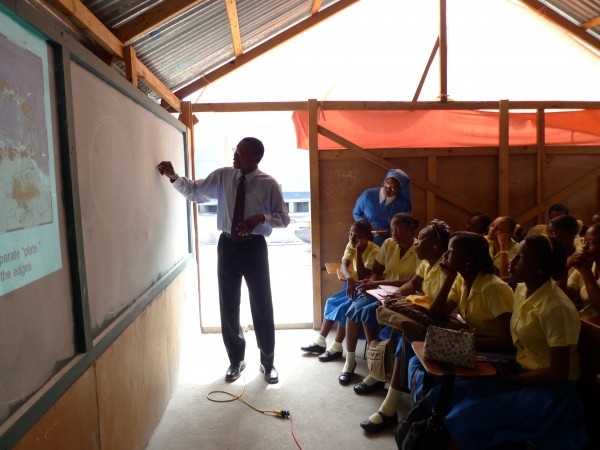1 October 2013
Let’s Talk Science
Posted by Olivia Ambrogio

Jean-Robert Altidor, from the Bureau des Mines et de l’Energie in Haiti, presents an outreach talk to school girls in Port-au-Prince. Besides installing seismometers with Altidor and other Haitian partners after the 2010 earthquake, guest blogger Susan Hough and USGS colleagues provided training to help develop outreach and education programs. Photo by Susan Hough.
By Susan Hough
Guest blogger Susan Hough, a seismologist with the U.S. Geological Survey (USGS) and an experienced public communicator and educator, offers some thoughts on reaching out to K-12 students—and other audiences.
As Earth Science week approaches, the attentions of the community turn to education and outreach. Within the broad E&O umbrella, effective communication with K-12 students remains a key priority. A small number of children will grow up to be scientists; all children will grow up to be stake-holders in society. It should be an easy job: even very young children are natural scientists, fascinated by experiments like, how does a liquid behave when I jump in this puddle? Or, how does my pacifier make its way to the floor and back to me if I throw it? (Do the laws of physics change after the 5th time?)
As children’s language and thinking capacities develop, it’s our responsibility as scientists to work alongside teachers and parents to foster rather than squelch their curiosity. For research scientists, a perennial challenge is to make and use wisely our opportunities to talk to children or K-12 educators. How do we talk science to little people who don’t speak our language?
Maybe we start by dropping the ‘little’ from the last sentence. When I was an undergraduate I had a small role working on an earthquake education project at the Lawrence Hall of Science in Berkeley. During this time one of the staff told me that, as a rule, one should assume that the general public, well-educated or no, understands science at the 7th grade level. I was naively shocked at the time: 7th grade means before any serious biology or chemistry, before almost all physics. Sometime later it hit me: this means there is no distinction between the level of the scientific understanding one should assume for adults versus teenagers. And preteens are not too far behind: in my experience they tend to be wise critters.
The implications of this are, it seems to me, two fold. First, there is no need to talk differently to junior-high students than to adults. Second, we need to be mindful to not talk over the heads of anyone, including college-educated non-specialists. I reached a third realization from years of pursuing non-specialist science writing as an avocation: effective science communication is not a matter of dumbing down, but rather of wising up. And we’re the ones who need to wise up.
Some science – string theory comes to mind – is genuinely difficult to get one’s head around. But let’s be honest here: very few AGU members are doing string theory. And the jargon that we know and love can be a handy crutch. Consider this: “Shaking from the 2011 Virginia earthquake was widely felt because the central/eastern US is a high-Q environment.” Seismologists say and accept this statement without blinking. The public has no idea what “high-Q” means. And what does it mean? Can we explain it in terms that make sense – to the public, and to ourselves?
Sometimes effective communication is a matter of recognizing and giving up our crutches, instead getting back to real words and first principles: “earthquake waves travel efficiently in the central/eastern US because they can reverberate within the earth’s crust, which is older, colder, and more uniform than in a place like California.” Analogies can be good. For example, few teenagers would relate to the notion of low-frequency seismic energy; every teenager relates to bass tones in music. Our audience is not dumb, they just don’t speak our language. That makes it our job to understand and speak theirs. At the end of the day a scientist has to look herself in the mirror and ask, is she smarter than a fifth grader?
— Susan Hough is a seismologist with the U.S. Geological Survey and a fellow of the American Geophysical Union.










 The Plainspoken Scientist is the science communication blog of AGU’s Sharing Science program. With this blog, we wish to showcase creative and effective science communication via multiple mediums and modes.
The Plainspoken Scientist is the science communication blog of AGU’s Sharing Science program. With this blog, we wish to showcase creative and effective science communication via multiple mediums and modes.